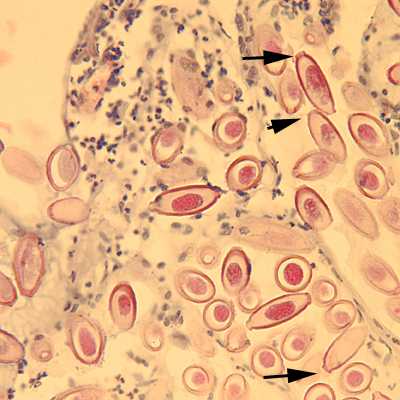
Case #163 - September, 2005
A 45-year-old man was admitted to a local emergency room in a comatose state after apparently having a heart attack. The man never regained consciousness and expired the next day. His patient history, gathered from his wife, included high blood pressure and high cholesterol levels as well as complaints of abdominal pain, intermittent diarrhea, noticeable weight loss, frequent headaches, and occasional shortness of breath for the past 5 months. His wife stated that he had been working abroad for one year in the Philippines and had just returned home for a one-week visit. An autopsy was performed to determine the cause of death. Figure A shows an image captured from a hematoxylin and eosin (H & E) stained slide of a section of intestinal tissue. Although not the cause of the man’s death, what is your diagnosis of this incidental finding? Based on what criteria?

Figure A
Case Answer
This case demonstrated the incidental finding of eggs of Capillaria spp. in the intestinal tissue. Diagnostic features included:
- thick-shelled eggs with prominent polar plugs found in the mucosa of the intestine, which is consistent with Capillaria spp.
- unembryonated eggs.
Eggs of Trichuris trichura also have prominent polar plugs, however the polar plugs of some Capillaria spp. tend to be flattened giving the eggs a more quadrate form; this can be seen in some of the eggs (black arrows, Figure A). The shells of the Capillaria spp. eggs shown in Figure A were also striated (faintly visible in a few eggs in the image). The patient’s travel history was also consistent with acquiring capillariasis, although it would not be a factor that would allow trichuriasis to be ruled out since this disease is found worldwide.

Figure A
More on: Intestinal Capillariasis
Images presented in the monthly case studies are from specimens submitted for diagnosis or archiving. On rare occasions, clinical histories given may be partly fictitious.
DPDx is an education resource designed for health professionals and laboratory scientists. For an overview including prevention and control visit www.cdc.gov/parasites/.
- Page last reviewed: August 24, 2016
- Page last updated: August 24, 2016
- Content source:
- Global Health – Division of Parasitic Diseases and Malaria
- Notice: Linking to a non-federal site does not constitute an endorsement by HHS, CDC or any of its employees of the sponsors or the information and products presented on the site.
- Maintained By:


 ShareCompartir
ShareCompartir